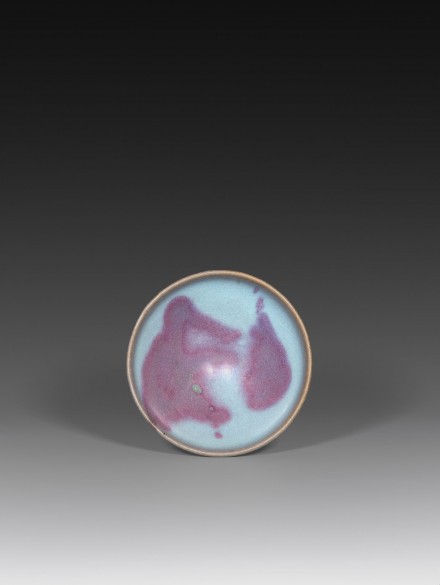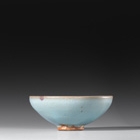J.J. Lally & Co., Oriental Art / New York City, New York
MenuPast Exhibition
The Gordon Collection:
Chinese Ceramics and Works of Art
March 12 - April 4, 2009

30.
A PURPLE-SPLASHED BLUE-GLAZED JUNYAO BOWL
Jin Dynasty (A.D. 1115-1234)
of almost hemispherical form, covered inside and out with a thick lavender-blue glaze boldly decorated on the interior with two large splashes of purplish tone shading to raspberry-red around the margins, and with a bright green spot near the center, the glaze shading to pale mushroom tone on the upturned rim, the small ring foot left unglazed and the exposed stoneware burnt brown in the firing.
Diameter 5 inches (12.7 cm)
No other Junyao bowl of this specific form and design appears to have been previously published, but a Junyao bowl of similar size with purple-splashed blue glaze excavated in Luoyang in 1982, now in the Luoyang Museum is illustrated in Complete Collection of Ceramic Art Unearthed in China: Henan, Beijing, 2007, no. 208, p. 208, where the author suggested a Yuan dynasty date but noted that Jin dynasty date has been suggested by other scholars.
The reddish-purple glaze used to decorate this Jun bowl, called mei gui se (rose-purple) in Chinese, is the earliest fully developed copper-red glaze in China. It was this technical innovation and aesthetic advance which made the Jun kilns famous, and this type of ‘splashed Jun’ ware has been most sought after by collectors since the Ming dynasty.
金 鈞窯天藍釉紫斑碗 徑 12.7 厘米
Additional Images (Touch to enlarge)
30.
A PURPLE-SPLASHED BLUE-GLAZED JUNYAO BOWL
Jin Dynasty (A.D. 1115-1234)
Diameter 5 inches (12.7 cm)
